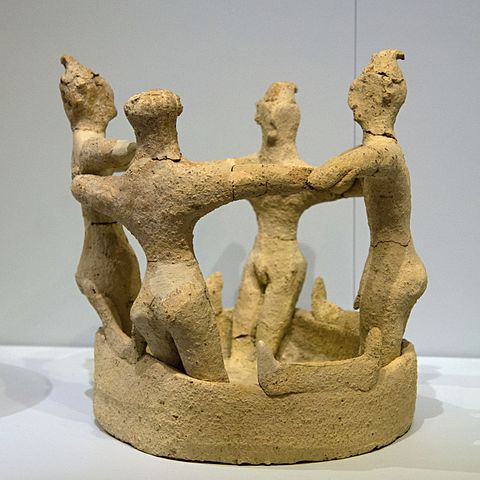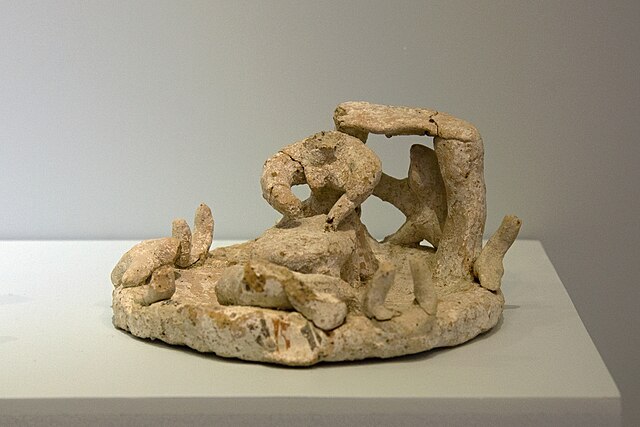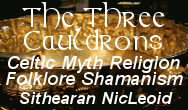Ariadne's Tribe: Minoan Spirituality for the Modern World
Walk the sacred labyrinth with Ariadne, the Minotaur, the Great Mothers, Dionysus, and the rest of the Minoan family of deities. Ariadne's Tribe is an independent spiritual tradition that brings the deities of the ancient Minoans alive in the modern world. We're a revivalist tradition, not a reconstructionist one. We rely heavily on shared gnosis and the practical realities of Paganism in the modern world. Ariadne's thread reaches across the millennia to connect us with the divine. Will you follow where it leads?
Find out all about Ariadne's Tribe at ariadnestribe.com. We're an inclusive, welcoming tradition, open to all who share our love for the Minoan deities and respect for our fellow human beings.
Modeling Ancient Religion: The Kamilari Finds
How do we know what Minoan religion was like? By looking... literally... at the artifacts they left behind.
We can't read what the Minoans wrote in their own language using the Linear A script. And the early form of Greek that the Mycenaeans wrote using the Linear B script amounts to little more than bookkeeping records from the Mycenaean occupation of Crete in the century or two before the Minoan cities were finally destroyed.
We've gleaned a few deity names and clergy titles from the Linear B tablets, but that doesn't tell us much about how the Minoans actually did religion. What did their practices look like?
A collection of terracotta models found in a tomb near the Minoan city of Phaistos tells an interesting story about some of the activities the Minoans considered sacred.
The Kamilari tholos tomb is one of three Minoan tombs found in central Crete near the southern coast of the island. It was used over the course of many years to bury multiple people.
Within the tomb and its multi-room annex, archaeologists found thousands (yes, thousands) of cups and jars that appear to have been used to make offerings - perhaps of wine - to the spirits of the dead. Some of these were enclosed within the tomb, suggesting that the offerings were part of funeral rites. Others were found on the plaza outside the tomb, perhaps relics of seasonal rituals to honor the ancestors.
But what's most fascinating about Kamilari is the small collection of terracotta models of human activities. Though some of them depict what could be considered mundane acts, bear in mind that Bronze Age cultures didn't conceive of a separation between the ordinary and the divine, the numinous. What do these models show?
The one at the top of this post is a depiction of a dining ceremony to honor the spirits of the dead. You can see four people seated along the back wall of this columned shrine. In front of each one stands a little table topped by a loaf of bread. But what's most interesting is on the other side of the tables - two spirits rise up out of the floor, ready to receive these offerings.
Inviting the ancestors to a meal and sharing food with them is an incredibly old tradition around the world. It's not surprising to see it depicted in a Minoan context.
Another model found at the tomb is often called the "Kamilari dancers."

Image via Wikimedia Commons
But these people aren't dancing. They're standing in a large vat with arms linked, the way people still do around the Mediterranean to stomp grapes for winemaking. The vat is decorated with four pairs of sacred horns, suggesting that this is no ordinary winemaking, but a special and sacred event.
You can't see it from the angle in the photo, but this model has another interesting feature: at least two of the figures standing in the vat have both breasts and penises. Make of that what you will.
In Ariadne's Tribe, we connect winemaking with Dionysus. But the Phrygian cap style peaked hats the grape-stompers are wearing also point to our god Korydallos.
Another terracotta model found at the tomb offers more questions than answers:

Image via Wikimedia Commons
So what's going on here? Is it, as archaeologists have suggested, a model of a woman making bread? The rocks around the edge of the model suggest an outdoor scene - at least, that's what rocks indicate in 2D Minoan art such as seal stones, seal rings, and frescoes.
Maybe she's making bread outdoors. Or maybe this is a scene of the so-called baetyl ritual, a sacred rite that also appears on Minoan seals. The baetyl ritual involves a person (both male-coded and female-coded images occur in the art) leaning over a large rock, usually with indications in the art of a deity's presence nearby.
Could the figure in the doorway behind the woman be a deity? Or perhaps it's another human, standing in a shrine doorway, participating in the rite in their own way.
Speaking of people leaning over big rocks <cough>, there's this model, also from Kamilari:

Image via Wikimedia Commons
What, you may ask, is going on here? That's a very good question.
We can see phallus-pillar-shaped stones in small shrines on some Minoan seal rings. This model is the only instance I'm aware of that involves a human interacting directly with one.
There are plenty of possibilities for the kind of ritual this model might represent. Yes, it could be sexual. Or the pillar might represent a deity or even the ancestors. It could be a good luck talisman. Without more context, we just can't tell. But it's really interesting to ponder.
What will future archaeologists think your spiritual practices were like, based on the items in your life?
Comments
-
Please login first in order for you to submit comments




















